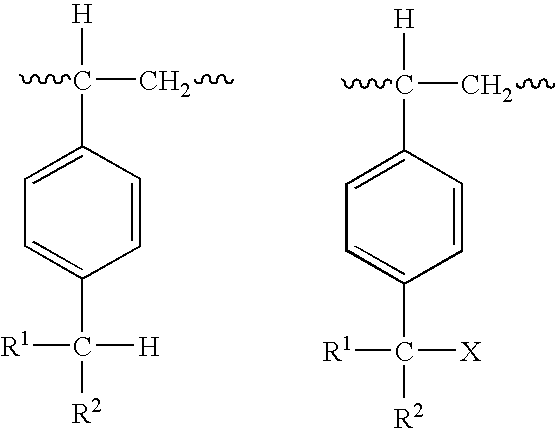Elastomeric blend for air barriers comprising grafted resin components
a technology of grafted resin and elastomer, which is applied in the direction of tyre parts, transportation and packaging, special tyres, etc., can solve the problems of uncured mass, uncured mass, and high cost of purification monomers, and achieves the effect of reducing the number of grafted resin components
- Summary
- Abstract
- Description
- Claims
- Application Information
AI Technical Summary
Benefits of technology
Problems solved by technology
Method used
Image
Examples
examples
[0126]The present invention, while not meant to be limiting by, may be better understood by reference to the following example and Tables.
Properties and Test Methods
[0127]Cure properties were measured using an ODR 2000 at the indicated temperature and 3.0 degree arc. Test specimens were cured at the indicated temperature, typically from 150° C. to 170° C., for a time (in minutes) corresponding to T90+appropriate mold lag. When possible, standard ASTM tests were used to determine the cured compound physical properties. Stress / strain properties (tensile strength, elongation at break, modulus values, energy to break) were measured at room temperature using an Instron 4202 or Instron 4204. Shore A hardness was measured at room temperature by using a Zwick Duromatic.
[0128]Oxygen permeability was measured using a MOCON OxTran Model 2 / 61 operating under the principle of dynamic measurement of oxygen transport through a thin film as published by R. A. Pasternak et al. in 8 JOURNAL OF POLYME...
examples 1-6
[0135]Examples 1-6 use a formulation of 100 phr Bromobutyl 2222. Other components and their amounts for each Example are shown in Table 5. Examples 1-4 are comparative examples using conventional tackifiers or no resin at all. Example 5 used EMFR 100. Example 6 used EMFR 100A. The examples were all tested for various physical properties, the results of which are outlined in Tables 6-7.
[0136]These components were mixed in a Banbury mixer in the absence of zinc oxide, MBTS and sulfur at a temperature of 65° C., mixed for about 5-10 minutes and discharged at about 150° C. Following cooling, the components were mixed in a second step on a two-roll rubber mill during which the curing agent and accelerator (zinc oxide, MBTS and sulfur) were thoroughly and uniformly dispersed at a relatively low temperature, e.g., 80° C. to 105° C. The final, green compounds, if required, were sheeted one more time on the two-roll mill. To measure cured properties, these compound compositions were cured at...
PUM
| Property | Measurement | Unit |
|---|---|---|
| brittleness temperature | aaaaa | aaaaa |
| glass transition temperatures | aaaaa | aaaaa |
| Tg | aaaaa | aaaaa |
Abstract
Description
Claims
Application Information
 Login to View More
Login to View More - R&D
- Intellectual Property
- Life Sciences
- Materials
- Tech Scout
- Unparalleled Data Quality
- Higher Quality Content
- 60% Fewer Hallucinations
Browse by: Latest US Patents, China's latest patents, Technical Efficacy Thesaurus, Application Domain, Technology Topic, Popular Technical Reports.
© 2025 PatSnap. All rights reserved.Legal|Privacy policy|Modern Slavery Act Transparency Statement|Sitemap|About US| Contact US: help@patsnap.com

